

Esperanto for Beginners. Introduction What is Esperanto?
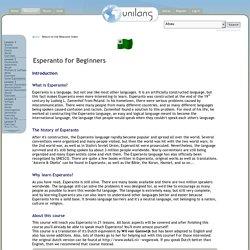
Esperanto is a language, but not one like most other languages. It is an artificially constructed language, but this fact makes Esperanto even more interesting to learn. Esperanto was constructed at the end of the 19th century by Ludwig L. How to type Esperanto Characters - New Zealand Esperanto Association. To jump to the instructions for enabling Esperanto Characters on your system click on the relevant link: or read on below for further background details.
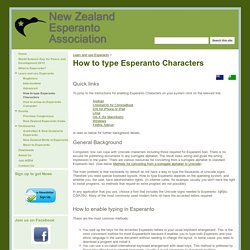
General Background Computers now can cope with Unicode characters including those required for Esperanto text. Ek! Dr. Esperanto's International Language. The original 1887 Esperanto proposal, back in print for a new millennium Dr.
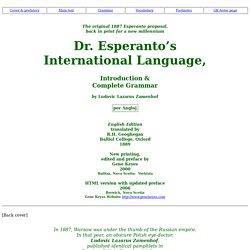
Esperanto’s International Language, Introduction & Complete Grammar. Ĉefpaĝo - Vikipedio. La ĉefpaĝo estas la enirpaĝo de retejo.
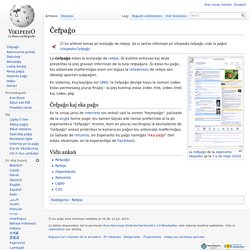
Ĝi kutime enhavas kaj skize prezentas la plej gravajn informojn de la tuta retpaĝaro. Ĝi estas tiu paĝo, kiu aŭtomate malfermiĝas kiam oni tajpas la retadreson de retejo sen detaligi apartan subpaĝon. En sistemoj, kiuj baziĝas sur UNIX, la ĉefpaĝo devige havu la nomon index. Estas permesataj pluraj finaĵoj - la plej kutimaj estas index.htm, index.html kaj index.php.
Ĉefpaĝo kaj eka paĝo En la unuaj jaroj de interreto oni ankaŭ uzis la vorton "hejmpaĝo", paŭsado de la angla home page, kiu tamen ŝajnas esti nenial preferinda al la pli esperanteca "ĉefpaĝo". Vidu ankaŭ. A Key to the Inter-National Language Esperanto. Every Esperanto word is pronounced as it is spelt, without exception.

The five vowels are a as in father, e as in set, i as in machine, o as in bone, u as in tune. (These guides are for U.S. English speakers.) The International Esperanto Community Encourages Learning Esperanto for Free Online: Resources. The Alphabet Esperanto has a twenty-eight letter alphabet, including six letters with diacritical marks.

The letters with diacritical marks are ĉ, ĝ, ĥ, ĵ, ŝ and ŭ. The alphabet consists of these letters: a b c ĉ d e f g ĝ h ĥ i j ĵ k l m n o p r s ŝ t u ŭ v z. The alphabet does not use q, w, x, or y unless they are in untranslated foreign names. A number of commonly available fonts support the Esperanto diacritical characters. Download the Esperanto diacritical characters in those fonts to cut and paste the correct characters when you type in Esperanto.
If you are interesting using alt codes on your Windows PC to type the characters, information is available in this Esperanto Diacritical marks blog post. Zamenhof also proposed a convention to allow the language to be used in printing (and now in computing). William Auld. Skota metodo. Pronunciation . . . . . . . . . Copied from lesson 4 If you can connect to the internet, you can listen to Esperanto pronunciation here: The Esperanto alphabet (28 letters): a b c ĉ d e f g ĝ h ĥ i j ĵ k l m n o p r s ŝ t u ŭ v z The names of the letters (used when spelling aloud, etc.) are: a bo co ĉo do e fo go ĝo ho ĥo i jo ĵo ko lo mo no o po ro so ŝo to u ŭo vo zo That is, the consonants get an 'o' after them, and the name of each vowel is the sound of the vowel itself.
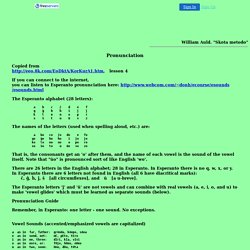
Note that "ŭo" is pronounced sort of like English 'wo'. The Language Construction Kit: Since you asked... Sidebar: The irregularities of Esperanto Hey, you asked.

The plural pronouns are separate lexical entries. Compare Quechua, where for example 'they' paykuna is formed by adding the regular plural suffix -kuna to the singular pronoun pay 'he, she'. Jordan: Pronouncing Esperanto. File last modified: 150629 Go to site main pageStudent Resources page Slightly Geeky Guide to Without Knowing Any Esperanto.
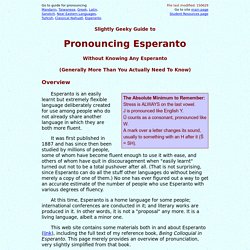
The alphabet and sounds of Esperanto. Esperanto: A Complete and Comprehensive Grammar/Alphabet and pronunciation. Alphabet[edit]
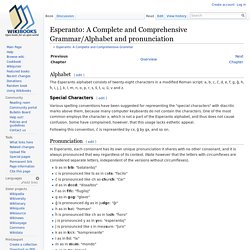
2 Writing and pronunciation. Esperanto uses Latin alphabet with 28 letters: A B C Ĉ D E F G Ĝ H Ĥ I J Ĵ K L M N O P R S Ŝ T U Ŭ V Z a b c ĉ d e f g ĝ h ĥ i j ĵ k l m n o p r s ŝ t u ŭ v z The letters are pronounced in the following way: c is pronounced [ʦ], roughly as ts in hats, ĉ [ʧ] ch in church, ĝ [ʤ], g in geography, ĥ [x], ch in Scottish English loch, ch in German Bach, j in Spanish Juan ĵ [ʒ], s in vision, ŝ [ʃ], sh in ship, ŭ is used in diphthongs, e.g., aŭ is pronounced [aʊ], as ow in how. The pronunciation of the other letters is the same as the pronunciation of the same letters in IPA.
Esperanto phonology. The creator of Esperanto, L. L. Zamenhof, illustrated Esperanto pronunciation by comparing its letters with their equivalents in several major European languages and declaring a principle of "one letter, one sound". Given that the comparison languages were not completely identical, he later advised that the pronunciation of Italian could be considered a model for Esperanto. The World of Esperanto Online. Esperanto language, alphabet and pronunciation. Esperanto is an international auxiliary language devised in 1887 by Dr. Ludwig Lazarus Zamenhof (1859-1917), an eye doctor, under the pseudonym of "Doktoro Esperanto".
He originally called the language "La Internacia Lingvo" (The International Language), but it soon became known as Esperanto, which means "the hoping one". Zamenhof was born in the Polish city of Bialystok which at that time was home to a polyglot, multiethnic mixture of Poles, Russians, Jews, Lithuanians and Germans. Free Esperanto Course. What Is Esperanto? Esperanto is a neutral international language created by L L Zamenhof in the end of the 19th century.
After more than a century since its inception, Esperanto is now spoken by hundreds of thousands - in fact, probably millions - of people all over the world. Today the objective of Esperanto is the same as always: to become the one foreign language everybody studies and learns. Is It Easy to Learn? While no foreign language is easy to master, Esperanto was intentionally designed to be as easy to learn as possible.